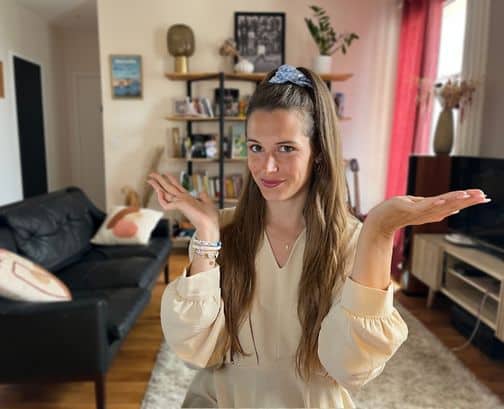In this video, I explain the differences between academic French and French spoken in "real life". Through 9 expressions, I show you what is different in each situation.
If you liked the video, don't hesitate to like it and subscribe to the channel, it encourages me a lot ! Thank you
0:00 - Introduction
0:32 - The negation
2:23 - These are
3:48 - "You" becomes "T
4:45 - "I" becomes "I
5:57 - "There is" becomes "There is
7:21 - This one / That one
8:17 - Please
9:09 AM - What is this?
9:51 - The bill
10:44 - Conclusion
Video transcript differences spoken language vs. academic French
Hello everyone. I hope you're well and having a good day. Today we're going to take a look at 9 differences between correct written French and the way we speak it. Before you start, don't forget to activate the subtitles to make this video easier to understand. And don't forget to subscribe to the Hellofrench channel so you don't miss a single video.
The first difference we're going to look at concerns negation in French, the difference between negation, the way we write negation and the way we mark it. In French, when we make a negative sentence, we find "ne" and a little further on "pas" or "n" "pas". In other words, the apostrophe "n". For example, I'm going to say je n'ai pas faim (I'm not hungry) or tu ne m'écoutes pas (You're not listening). The "ne" becomes an "n'" when a word with a vowel follows. Here, for example, it's "je n'ai". The vowels in French are a e i o u and y.
The difference between written and spoken negation is that very often, when speaking, the French will remove the "ne" or the "n'". Instead of saying "je n'ai pas faim", we'll often say "j'ai pas faim", or instead of saying "tu ne m'écoutes pas", we'll say "tu m'écoutes pas". The negation will only be marked by the "not".
The second difference concerns "c'est" and "ce sont". In correct French, when writing, if I'm speaking in the singular, I'll say "c'est mon chien". If I'm speaking in the plural, I'll say "ce sont mes chiens". I'll say "c'est Catherine" because there's only one person, but if there are two people, I'll say "ce sont Catherine et Vincent".
Very often, when we speak, instead of marking the plural by putting the verb in the plural, we'll say "it's" all the time. For example, I'll say "c'est mes chiens", "c'est Catherine et Vincent". So, of course, it's a mistake, since we should normally agree, but in spoken language, that's very often how we talk.
The third difference between written and spoken French concerns the "tu", which becomes an apostrophe "t" when spoken. For example, in correct French, I would normally say "tu es content" or "tu as du temps pour m'aider?
Very often, when speaking, "tu" will turn into "t'". So, instead of saying "are you happy?", I'll say "are you happy?" or instead of saying "do you have time to help me?" I'll say "do you have time to help me?"
The next difference concerns the "je", which becomes the apostrophe "j". Sometimes, the "je" becomes "j'" in front of vowels. This is perfectly normal. For example, I'll say "je vais bien" (I'm fine), but I'll say "j'ai des cheveux blonds" (I have blond hair), so that's normal, that's correct French, both written and spoken.
For example, instead of saying "I want a glass of water", I'll say "I want a glass of water", or instead of saying "I'm fine", I'll say "I'm fine".
The next difference concerns the expression "il y a", which becomes "y a" when spoken. This expression "il y a" in French is used in different contexts, in different situations. The first is to talk about a past event. For example, I might say "I got my driver's license two years ago". It can also be used to designate something in context, something or someone in the present context, in what is happening right now.
For example, I can say "there are two pastries in the fridge, choose your favorite".
Very often, "il y a" will be contracted to be said more quickly. For example, I'll say "I got my driver's license two years ago". Or "there are two pastries in the fridge, choose your favorite". The next difference concerns "celui-ci" and "celui-là", which become "çui-ci" and "çui-la" when spoken. For example, if someone asks me "would you like some cheese?", I can answer "yes, that one, oh no, rather that one".
Very often, we'll contract the word and I'll respond if we ask the same question, "Do you want cheese?" I'll say "yes, this one, oh no, more like that one."
The next difference concerns the expression "s'il te plaît". S'il te plaît" is a polite expression used when you're on first-name terms with someone. When you're on first-name terms, the most polite version is "s'il vous plaît", but when you're on first-name terms, you say "s'il te plaît".
"S'il te plaît", turns into "s'te plaît". For example, instead of saying "Can I have a glass of water please?", I'll say "Can I have a glass of water please?"
The next difference concerns "qu'est-ce que", which is often transformed into "qu'est-ce". For example, instead of saying "what do you want to eat? I'll say "what do you want to eat?". "What do you prefer? Pizza or pasta?" I'll say "what do you prefer? Pizza or pasta?" The "que" is often omitted.
The next difference concerns "oui" in French. "Oui" is the opposite of "non". Very often, when French people speak, "oui" will turn into "ouais". For example, if I ask you "Are you learning French?" You might answer "ouais, j'apprends le français" instead of saying "oui, j'apprends le français".
As I said, it's in colloquial language. You can't say that in a restaurant or with your boss. Besides, in French, there are lots of different ways of saying "oui", of showing that you agree, depending on the context. In fact, I'll be making a new video very soon to explain and teach you different ways of saying "yes" depending on the context, the situation and the person you're talking to. That's it for today.
I hope you enjoyed this video. If you liked it, put a like and, above all, subscribe to the channel so you don't miss any video.
See you soon.








